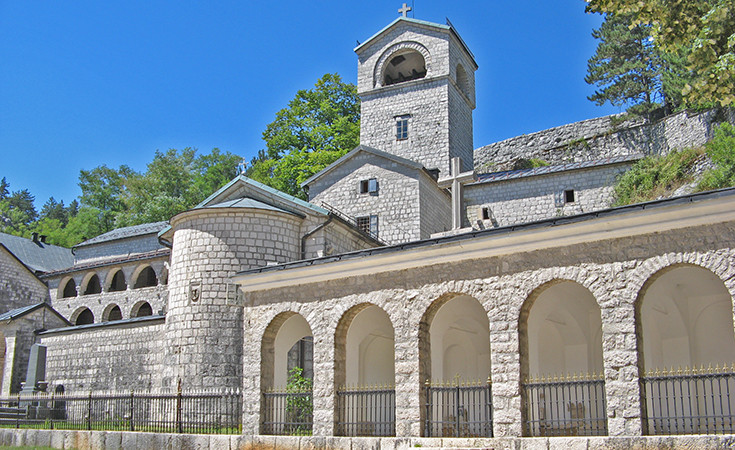
The Cetinje Monastery is located in the city center, at the foot of the Orlov Krš mountain. Ivan Crnojević, the ruler of Zeta, founded the monastery at the end of the 15th century. Sultan Mehmed II, also known as Mehmed the Conqueror, attacked Zeta in 1479, forcing Crnojević to flee the country and hide in Italy. Legend has it that while in Italy, Ivan Crnojević visited Ancona and had the opportunity to see a church dedicated to the Mother of God, which was so beautiful that he vowed to build a similar religious building once he returns to Montenegro.
In 1481, Mehmed II died, which enabled Crnojević to return to Montenegro. He moved his residency from the Shkodra Lake to Cetinje at the foot of the Lovćen mountain, making the capital difficult for his enemies to approach, and it was in Cetinje that Ivan Crnojević built the monastery in 1484, moving the Metropolitanate’s seat to the site. Ivan gifted the monastery with land and forests, as well as everything they needed for the Metropolitanate to function and develop perfectly.
The Cetinje Monastery originally consisted of the church dedicated to the Birth of the Mother of God, a small church of Saint Apostle Peter, dwellings for the priests, agricultural buildings, as well as a gun storage. After the death of Ivan Crnojević, his son Đorđe inherited the throne, establishing a printing shop in Cetinje, which opened its doors in 1493. The shop was quickly moved to the monastery, with the first printed book being the Oktoih, or Osmoglasnik, an Orthodox Christian prair book, consisting of poems about the Resurrection of Christ. The first printed edition is still kept in the monasterial museum.
During the Morean War, which occured between 1684 and 1699, which saw the armies of the Republic of Venice and the Ottoman Empire clash, the monastery was completely destroyed. This was mostly due to the fact that the monastery was a base of the army of the Republic of Venice, which the Turks tried to conquer. Having set explosives in the monastery, the Venetian Army retreated and activated the explosives, killing several hundred Ottoman soldiers, taking the monastery with them.
In 1702, Metropolitan Bishop Danilo ordered the construction of a new monastery, at the slope of the Oro mountain. During the construction, material salvaged from the ruins of the old monastery was used to build the new one. Unfortunately, constant clashes with the Ottomans in the area resulted in the new monastery being demolished in 1714. The Turkish army of around 100 thousand soldiers pillaged the country after the monastery fell. After the defeat, Bishop Danilo travelled to Russia in 1715 to ask Russian Tzar Peter I for help in rebuilding the destroyed country. He received the money in the royal city of Saint Petersburg, rebuilding the Cetinje Monastery in 1724 thanks to the financial aid of Russia.
During the rule of Saint Petar of Cetinje, whose name was originally Petar I Petrovič Njegoš, the monastery was demolished once again by Pasha Mahmud Bušatlija in 1785. During his next attack, the Pasha was murdered (interestingly, the Montenegrin army was led by Saint Petar carrying a cross), and his skull is still kept in the Cetinje Monastery as a symbol of Montenegro’s great victory. Saint Petar Cetinjski rebuilt the monastery, building a new dwelling for the monks which can still be seen today.
Saint Petar decided that Petar II Petrović Njegoš would ascend to throne after him. Petar II went on to expand the monasterial grounds even further, and during his reign, the monastery held a working printing shop, school, and many internationally famous people came to the monastery, inculding Russian Counts of the time.
We could say that the country prospered the most during Petar II’s rule. The Metropolitan Bishops that came later helped the monastery become what it is today.
The monastery houses the remains of St. Petar of Cetinje, as well as the right hand of John the Baptist and a grain from the Holy Cross, which are some of the world’s most important Christian relics. Also, the cell in which St. Petar lived is preserved, and this is where a grain from the remains of St. Theodore Stratelates are held. In addition to this, the crown of Stefan Dečanski, the epitrachelion that belonged to Saint Sava, clothing belonging to Montenegrin Metropolitan Bishops, as well as numerous gifts from Russian Tzars to Montenegro and its rulers are also housed in the monastery, as well as priceless collection of manuscripts and books dating back to the 13th century.
Although not rich in its appearance, the monastery is a priceless cultural, religious and spiritual treasure of Montenegro. We highly recommend you visit the monastery during your trip to Cetinje.
THE ENTRANCE TO THE MONASTERY IS FREE OF CHARGE.
Taking pictures inside the monastery is prohibited. Appropriate clothing should be worn when visiting the site.
Author of the text:

Marijana Niković licensed tourist guide for Montenegro.
If you are interested in guided tours in English, please contact me at:
(Viber) 00382 68 230 241
![]()